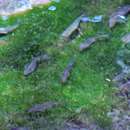Diagnostic Description
provided by Fishbase
Entirely naked (scale only shown on lateral line in specimens > 5 cm TL; head profile obtuse. Color is dark brown, greenish, the belly is cream; there is a copper-colored band on the flanks (Ref. 35685).
Morphology
provided by Fishbase
Dorsal spines (total): 0; Dorsal soft rays (total): 12; Analspines: 0; Analsoft rays: 19
Biology
provided by Fishbase
Medium sized fish considered to be the most southern characid living in temperate waters. Young with very tiny soft and delicate scales which are reabsorbed into the skin making the skin greasy and often with granulated or spongy appearance (Ref. 7252).
Importance
provided by Fishbase
fisheries: of no interest; aquarium: commercial
Comprehensive Description
provided by Smithsonian Contributions to Zoology
Gymnocharacinus bergi Steindachner, USNM 313878, 3, 34.5–44.3 mm; Argentina, Provincia Río Negro, Estancia El Rincon
Hemibrycon dariensis Meek and Hildebrand, USNM 293245, 2, 44.0–57.4 mm; Panama, Darien, Rio Pucuro.
- bibliographic citation
- Vari, Richard P. 2001. "Phylogenetic study of the neotropical fish genera Creagrutus Günther and Piabina Reinhardt (Teleostei:Ostariophysi:Characiformes), with a revision of the cis-Andean species." Smithsonian Contributions to Zoology. 1-239. https://doi.org/10.5479/si.00810282.613
Comprehensive Description
provided by Smithsonian Contributions to Zoology
Gymnocharacinus bergi, 30
gyrospilus, Creagrutus, 2, 48, 113–116
Hemigrammocharax, 36
Hemiodus, 23
Hemistichodus, 19
Hepsetus, 23
hildebrandi, Creagrutus, 2, 63, 65
holmi, Creagrutus, 2, 48, 77, 116–119
Hoplias, 23
hujela, Ctenolucius, 27
hysginus, Creagrutus, 2, 48, 77, 119–122, 208
Ichthyborus, 19
ignotus, Creagrutus, 2, 48, 122–125
Iguanodectes, 19, 29
iheringi, Bryconamericus, 21, 29
ilsea, Roeboides, 27
innesi, Paracheirodon, 12
intermedius, Nannocharax, 34
kunturus, Creagrutus, 2, 48, 125–128
lassoi, Creagrutus, 2, 48, 77, 116, 128–131, 134
lateralis, Alestes, 21, 29
lepidus, Creagrutus, 2, 48, 77, 130, 131–134
- bibliographic citation
- Vari, Richard P. 2001. "Phylogenetic study of the neotropical fish genera Creagrutus Günther and Piabina Reinhardt (Teleostei:Ostariophysi:Characiformes), with a revision of the cis-Andean species." Smithsonian Contributions to Zoology. 1-239. https://doi.org/10.5479/si.00810282.613
Comprehensive Description
provided by Smithsonian Contributions to Zoology
Osteologia y lepídologia de Gymnocharacinus bergi (Pisces Characidae). Limnobios, La Plata, 2(7):491–512
Myers, G.S.
1927. Descriptions of New South American Fresh-Water Fishes Collected by Dr. Carl Ternetz. Bulletin of the Museum of Comparative Zoology, 68(3):107–135.
1928. New Fresh-Water Fishes from Peru, Venezuela, and Brazil. Annals and Magazine of Natural History, series 10, 2:83–90.
1958. Trends in the Evolution of Teleostean Fishes. Stanford Ichthyological Bulletin, 7(3):27–30.
1960. The South American Characid Genera Exodon, Gnathoplax, and Roeboexodon, with Notes on the Ecology and Taxonomy of Characid Fishes. Stanford Ichthyological Bulletin, 7(4):206–211.
Myers, G.S., and T.R. Roberts
1967. Note on the Dentition of Creagrudite maxillaris, a Characid Fish from the Upper Orinoco-Upper Rio Negro System. Stanford Ichthyological Bulletin. 8(4):248–249.
Nelson, G.
1969. Gill Arches and the Phylogeny of Fishes with Notes on the Classification of the Vertebrates. Bulletin of the American Museum of Natural History. 141 (4):475–522.
1973. Relationships of the Clupeomorpha, with Remarks on the Structure of the Lower Jaw in Fishes. Zoological Journal of the Linnean Society, London. 53(supplement):333–349.
Nielsen, J.
1974. Fish Types in the Zoological Museum of Copenhagen. 115 pages. Copenhagen: Zoological Museum, University of Copenhagen.
Ortaz, M
1992. Habitos alimenticos de los peces de un rio de montaña neotropical. Biotropica. 24(4):550–559.
1997. Ciclo reproductivo de Creagrutus bolivari (Pisces: Characidae) en Venezuela. Revista de Biologia Tropical, 45(3): 1147–1153.
Ortega, H.
1992. Biogeografia de los peces de aguas continentales del Peru, con especial referencia a especies registradas a altitudes superiores a los 1000 m. Memorias del Museo de Historia Natural, U.N.M.S.M., 21:39–45.
1996. Ictiofauna del Parque Nacional Manu, Perú. In D.E. Wilson and A. Sandoval editors. Manu. The Biodiversity of Southeastern Peru. pages 453–482. Washington, D.C.: Smithsonian Institution Press.
Ortega, H., and R.P. Vari
1986. Annotated Checklist of the Freshwater Fishes of Peru. Smithsonian Contributions to Zoology. 437:1–25.
Orti, G., and A. Meyer
1997. The Radiation of Characiform Fishes and the Limits of Resolution of Mitochondrial Ribosomal DNA Sequences. Systematic Biology, 346(1):75–100.
Ouboter, P.E., and J.H.A. Mol
1993. The Fish Fauna of Suriname. In P.E. Ouboter, editor. Freshwater Ecosystems of Suriname, pages 133–154. The Netherlands: Kluwer Academic Publishers.
Ovchynnyk, M.M.
1968. Annotated List of the Freshwater Fish of Ecuador. Zoologischer Anzeiger. 181:237–268.
Patterson, C.
1975. The Braincase of Pholodophorid and Leptolepid Fishes with a Review of the Actinopterygian Braincase. Philosophical Transactions of the Royal Society, series B, 269:275–579.
Pavlov, D.S., V.K. Nezdoliy, A.K. Urteaga, and O.R. Sanches
1995. Downstream Migration of Juvenile Fishes in the Rivers of Amazonian Peru. Journal of Ichthyology, 35(9):227–248. [Originally published in Russian in Voprosy Ikhtiologii, 35(6):753–767.]
Pearse, A.S.
- bibliographic citation
- Vari, Richard P. 2001. "Phylogenetic study of the neotropical fish genera Creagrutus Günther and Piabina Reinhardt (Teleostei:Ostariophysi:Characiformes), with a revision of the cis-Andean species." Smithsonian Contributions to Zoology. 1-239. https://doi.org/10.5479/si.00810282.613
Naked characin
provided by wikipedia EN
The naked characin (Gymnocharacinus bergii) is a small species of fish in the family Characidae.[1] It is the southernmost member of the family (together with some Cheirodon species from Chile) and the only member of the genus Gymnocharacinus. It is endemic to a stream near Valcheta in northern Patagonia, Argentina. Adults have no scales. It is endangered because of habitat loss.
References

- license
- cc-by-sa-3.0
- copyright
- Wikipedia authors and editors
Naked characin: Brief Summary
provided by wikipedia EN
The naked characin (Gymnocharacinus bergii) is a small species of fish in the family Characidae. It is the southernmost member of the family (together with some Cheirodon species from Chile) and the only member of the genus Gymnocharacinus. It is endemic to a stream near Valcheta in northern Patagonia, Argentina. Adults have no scales. It is endangered because of habitat loss.
- license
- cc-by-sa-3.0
- copyright
- Wikipedia authors and editors

